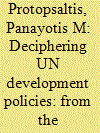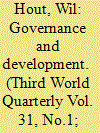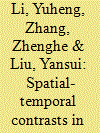|
|
|
Sort Order |
|
|
|
Items / Page
|
|
|
|
|
|
|
| Srl | Item |
| 1 |
ID:
153137


|
|
|
|
|
| Summary/Abstract |
A comparative analysis of the United Nations (UN) resolutions on the development decades reveals an evolution of the UN policies: a gradual shift from the modernisation paradigm to the human development approach, even though the goal of economic growth was never entirely abandoned. Despite this evolution, all relevant resolutions define quantitative targets on inputs and outputs to be met through recommended policy measures involving state intervention in the economy and the society, introduced into developing countries’ plans for development, in accordance with the teachings of the modernisation paradigm.
|
|
|
|
|
|
|
|
|
|
|
|
|
|
|
|
| 2 |
ID:
095894


|
|
|
|
|
| Publication |
2010.
|
| Summary/Abstract |
Interest in China's capacity for environmental governance is growing, in line with its environmental woes and exponential economic growth.Environmental policy efforts have lacked effectiveness, confirming the persistence of a disjuncture between promise and performance.This article contributes to the debate through the analytical lens of Environmental Policy Integration(EPI): a normative concept and governance regime indispensable to sustainable development. It finds that China.
|
|
|
|
|
|
|
|
|
|
|
|
|
|
|
|
| 3 |
ID:
095173


|
|
|
|
|
| Publication |
2010.
|
| Summary/Abstract |
This introductory article to the special issue on European Union, development policies and governance discusses how notions of ('good') governance have come to dominate development discourses and policies since the mid-1990s. The article argues that governance was part of the so-called Post-Washington Consensus, which understands governance reform as part of the creation of market societies. Although academics have commonly emphasised the fact that governance concerns the rules that regulate the public sphere, the dominant understanding of (good) governance in policy circles revolves around technical and managerial connotations. The second part of the article introduces some important features of EU development policy, and argues that this is essentially neoliberal in nature and favours a technocratic approach to governance reform. The EU's main instrument in relations with developing countries is the Country Strategy Paper, which includes a set of governance indicators for the assessment of the political situation in partner countries. In addition, the European Union has developed a 'governance profile', which consists of nine components.
|
|
|
|
|
|
|
|
|
|
|
|
|
|
|
|
| 4 |
ID:
114878


|
|
|
| 5 |
ID:
143652


|
|
|
|
|
| Summary/Abstract |
The study explores through a ‘transnational lens’ the Romanian media construction of remitting practices and identities within a wider debate on circular migration. It uses a broad definition of remittances (financial, sociocultural and political) and is concerned with the role of the Romanian press in articulating migrant–non-migrant relationships and laying the ground for informed policy debates. The methodology consists of qualitative corpus analysis and discourse analysis applied to a corpus of 221 news articles. The main findings indicate an overall positive evaluation of remittances (with the main exception of family separation), which endows migrants with social recognition as development agents and is used to justify various policy initiatives, but at the same time disempowers them through instrumentalisation. Even though limited in scope, grassroots migrant–non-migrant interaction, combined with a critical journalistic stance in editorials, opens up an avenue towards negotiation and joint transnational actions.
|
|
|
|
|
|
|
|
|
|
|
|
|
|
|
|
| 6 |
ID:
178430


|
|
|
|
|
| Summary/Abstract |
Despite poverty being a multi-dimensional concept, binary poor/non-poor classifications and money-metric poverty measures remain prominent in calculating official poverty figures. This article highlights that conventional two-way poverty classifications ignore the huge disparities within ‘poor’ and ‘non-poor’ groups. The study thus argues for a new approach in the context of Sri Lanka to recognise four poverty types, namely ‘extremely poor’, ‘poor’, ‘vulnerable non-poor’ and ‘non-poor’, along with calculations of poverty incidence based on these new criteria. This allows for the development of policies to alleviate poverty in general, while paying special attention to the ‘vulnerable non-poor’ category, which has not been addressed in most development policies.
|
|
|
|
|
|
|
|
|
|
|
|
|
|
|
|
| 7 |
ID:
126789


|
|
|
|
|
| Publication |
2013.
|
| Summary/Abstract |
For a long period following the establishment of People's Republic of China in 1949, urban and rural areas were treated separately and differently. Since 1978, China has experienced over three decades of rapid economic growth, with annual growth rates of over 9 per cent. However, despite this "economic miracle", the country has also witnessed ever-enlarging urban-rural inequalities across a range of indicators such as income, education, medical care, provision of infrastructure and social insurance. For example, while the per capita urban household income increased from 343 yuan in 1978 to 13,041 yuan in 2007, over the same period the per capita rural household income increased from 134 yuan to only 3,998 yuan. (1) A cluster of studies that investigated urban-rural inequalities in China have attributed the inequalities to factors such as a dualistic urban-rural structure, (2) urban-biased development strategy, (3,4) market forces (5) and taxation. (6) Urban-biased policies and related measures like the household registration system (hukou) were initially formulated on the basis of the typical socio-economic conditions in China in the period after 1949. These policies and measures have, however, intentionally diverted resources (capital, labour and materials) from rural to urban areas, and induced greater urban-rural inequality in China.
|
|
|
|
|
|
|
|
|
|
|
|
|
|
|
|
|
|
|
|
|